
Cantellation (geometry)


In geometry, a cantellation is a 2nd-order truncation in any dimension that bevels a regular polytope at its edges and at its vertices, creating a new facet in place of each edge and of each vertex. Cantellation also applies to regular tilings and honeycombs. Cantellating a polyhedron is also rectifying its rectification.

Cantellation (for polyhedra and tilings) is also called expansion by Alicia Boole Stott: it corresponds to moving the faces of the regular form away from the center, and filling in a new face in the gap for each opened edge and for each opened vertex.

Notation
A cantellated polytope is represented by an extended Schläfli symbol t0,2{p,q,...} or r or rr{p,q,...}.

For polyhedra, a cantellation offers a direct sequence from a regular polyhedron to its dual.

Example: cantellation sequence between cube and octahedron:


Example: a cuboctahedron is a cantellated tetrahedron.

For higher-dimensional polytopes, a cantellation offers a direct sequence from a regular polytope to its birectified form.

Examples: cantellating polyhedra, tilings
| Form | Polyhedra | Tilings | |||
|---|---|---|---|---|---|
| Coxeter | rTT | rCO | rID | rQQ | rHΔ |
| Conway notation |
eT | eC = eO | eI = eD | eQ | eH = eΔ |
| Polyhedra to be expanded |
Tetrahedron | Cube or octahedron |
Icosahedron or dodecahedron |
Square tiling | Hexagonal tiling Triangular tiling |
| Image | 
|

|

|
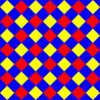
|
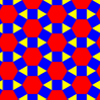
|
| Animation | 
|

|

|
||
| Coxeter | rrt{2,3} | rrs{2,6} | rrCO | rrID |
|---|---|---|---|---|
| Conway notation |
eP3 | eA4 | eaO = eaC | eaI = eaD |
| Polyhedra to be expanded |
Triangular prism or triangular bipyramid |
Square antiprism or tetragonal trapezohedron |
Cuboctahedron or rhombic dodecahedron |
Icosidodecahedron or rhombic triacontahedron |
| Image | 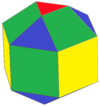
|

|
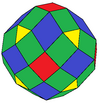
|
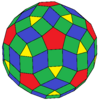
|
| Animation | 
|

|
See also
References
- Coxeter, H.S.M. Regular Polytopes, (3rd edition, 1973), Dover edition, ISBN 0-486-61480-8 (pp.145-154 Chapter 8: Truncation, p 210 Expansion)
- Norman Johnson Uniform Polytopes, Manuscript (1991)
- N.W. Johnson: The Theory of Uniform Polytopes and Honeycombs, Ph.D. Dissertation, University of Toronto, 1966
External links
See what we do next...
OR
By submitting your email or phone number, you're giving mschf permission to send you email and/or recurring marketing texts. Data rates may apply. Text stop to cancel, help for help.
Success: You're subscribed now !


